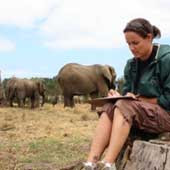A while ago I asked our volunteers to start a daily diary, where each one would fill in observations about the day…they didn't have to be scientific about it…just to write a few lines about what they did, what the elephants were up to and interesting and/or funny things that happened. It has developed into a wonderful "in their own words" account of the daily goings-on at the Knysna Elephant Park!
Herewith a few choice excerpts….
Sept 2, 2010
Eventful morning at the Park, as Keisha, who despite her youth, was unceremoniously chased for well over an hour by Namib and Harry, who were trying to mate with her. She seems somewhat receptive in that she will present when approached and is obviously secreting something, but as soon as they try and mount her, she runs away. She is faster and smaller than the boys, so could easily escape while they trotted behind with their penis hanging out. Harry seems to prefer the full on chase and is faster. Namib tried the quiet sneak approach to see if that would be more successful
Laurie (Canada)
Sept 3, 2010
Harry and Namib still unsuccessful in attempts to catch Keisha. Half day today – into town to get groceries. Dinner at the Market in Plett. Fun atmosphere.
Sept 4, 2010
Saturday – Isaure arrives. Volunteers spend the day at Tenikwa Wild Cat Sanctuary and have a lovely lunch in the Crags. Sundowners for Dr. Debbie's birthday at the Ski Boat Club. Great dolphin sightings and a lovely evening.
Sept 12, 2010
It was a good sunny day. In the morning all the volunteers went for a ride. It was so nice. For myself, it was the first time to ride an elephant. It's an experience that I would never forget. After that we were doing activity budgets. I like doing that because you spend a lot of time with the elephants and guides. In the evening we were busy entering data into the computer. Every day it's just a new day at Knysna with elephants around you, I love that!
Emmanuelle (Malawi)







